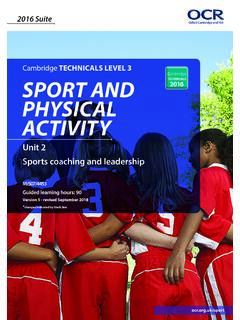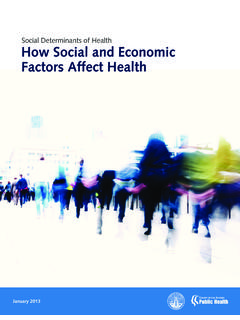Transcription of Physical activity and sedentary behaviour Evidence summary
1 About this summaryRegular Physical activity contributes to good health across all life stages, whereas inactivity is one of the most significant contributors to the global burden of disease (Lee et al. 2012). Sedentar y behaviour , including time spent sitting each day, is emerging as an independent risk factor for health (Owen et al. 2010). Moving more and sitting less is impor tant for Physical and mental health and wellbeing, and delivers a range of other economic, social and environment Evidence summar y outlines current Physical activity and sedentar y behaviour levels in Australia and in Victoria. It provides an over view of the impacts of Physical activity and sedentar y behaviour , as well as barriers to and enablers of active lifestyles. It has been informed by a literature review, which drew Evidence from systematic reviews and meta-analyses published between 2009 and June 2014, recent studies, and relevant government and non-government agency Evidence summar y draws upon the best available Evidence and exper t opinion, while recognising the challenges in measuring Physical activity and sedentar y behaviour , including different sources and availability of significant trend RESOURCESFor information on VicHealth s Physical activity programs, research and initiatives, visit DefinitionsActive travel refers to non-motorised transpor t between destinations such as walking, cycling, scooting and skate-boarding (VicHealth 2014).
2 Physical activity defined as any bodily movement produced by skeletal muscles that results in energ y expenditure (Caspersen et al. 1985) and is accumulated in four main domains: leisure/recreation; transport; occupational/school; and household. Physical activity includes exercise (planned, structured and repetitive activity with a fitness goal), spor t (organised, club and social), unstructured/incidental Physical activity (such as gardening ), active play and walking (for recreation and transpor t). Physical inactivity defined as a lack of Physical activity ( WHO 2015).Screen-time the time spent using a screen-based device such as television, computer, or electronic gaming behaviour defined as any waking activity characterised by low energ y expenditure ( metabolic equivalents) and a sitting or reclining posture (Sedentar y behaviour Research Network 2012). It includes sitting at work or school, car travel, and screen-time (television viewing, video game playing, computer use for leisure).
3 Sport defined as a human activity capable of achieving a result requiring Physical exer tion and/or Physical skill which, by its nature and organisation, is competitive and is generally accepted as being a spor t (Australian Spor ts Commission ). activity and sedentary behaviour Evidence summaryEncouraging regular Physical activity is one of five strategic imperatives in the VicHealth Action Agenda for Health Promotion. VicHealth recognises the many health benefits that an active lifestyle can provide. National guidelines for Physical activity and sedentary behaviourThe table below summarises Australia s Physical activity and Sedentar y behaviour Guidelines, which were last updated in 2014 (Department of Health 2014a).Age groupPhysical activity sedentary behaviour Early childhood0 5 years 3 hours of light- to vigorous- intensity activity ever y day No screen-time for children under 2 years of age Less than 1 hour of screen-time per day for children aged between two and five No more than 1 hour of being sedentar y or inactive at a time, except when sleeping, for all children aged bir th to 5 yearsChildren and youth5 17 years At least 1 hour of Physical activity ever y day Bone and muscle streng thening activities at least 3 days each week Minimise sedentar y time ever y day Less than 2 hours of screen-based entertainment per day Break up long periods of sitting as of ten as possibleAdults18 years and over Between 2 and 5 hours of moderate intensity Physical activity , or between 1 and 2 hours of vigorous intensity Physical activity , each week activity on most, and preferably all.
4 Days Muscle streng thening activities at least 2 days each week Minimise prolonged sitting Break up long periods of sitting as of ten as possibleOlder adults65 years and over At least 30 minutes of moderate intensity Physical activity on most, preferably all, days activity each day, in as many ways as possible, doing a range of Physical activities Incorporate activities that promote fitness, streng th, balance and flexibilityPhysical activity and sedentary behaviour : Evidence summary2 Physical activity outcomes and impactsPhysical activity is associated with many Physical and mental health benefits, a s well as social, economic and environmental all age groups, Physical activity is related to lower obesity risk and better fitness, bone health and cognitive per formance (Lee et al. 2012, Okely et al. 2013). Physical health Physical inactivity is responsible for more than five million deaths globally per year (Lee et al. 2012).Being active lowers the risk of colon cancer, type 2 diabetes and cardiovascular disease in adults (Boyle et al.)
5 2012, Lee et al. 2012). Spor t and recreation par ticipation is related to reduced over weight or obesity and improved Physical fitness (Khan et al. 2012).Active travel contributes to lower obesity risk and premature cardiovascular disease mor tality among adults, and improved fitness in children and youth (Larouche 2014a, Larouche et al. 2014b, Xu et al. 2013).Reducing the prevalence of Physical inactivity among Australian adults by 10 per cent would reduce: deaths attributed to Physical inactivity by 15 per cent per year disability adjusted life years lost by 14 per cent new cases of Physical inactivity-related diseases by 13 per cent per year (Cadilhac et al. 2011).Mental healthPar ticipation in spor t and recreation is associated with fewer depressive symptoms, better mental and social health, teamwork skills, social interaction and friendships and feelings of belongingness among children and adolescents (Eime et al. 2013). Walking can deliver a community benefit by increasing social connections and public safety (Burke et al.
6 2014). Active children and youth are more socially active, have reduced symptoms of depression and anxiety and have better academic per formance (Eime et al. 2013, Hoare et al. 2014, Singh et al. 2012). Being active enhances psychosocial wellbeing and cognitive per formance in adults (Reed & Buck 2009, Smith et al. 2010).Economic Household spending on spor ting goods and ser vices contributes $ billion to the Australian economy each year, and employment in the spor t sector contributes another $442 million (Australian Bureau of Statistics 2011).In 2008, the total annual economic cost of Physical inactivity in Australia, including healthcare, productivity and mor tality costs, was estimated at $ billion (Medibank 2008). Reducing Physical inactivity in Australia by 10 per cent is estimated to reduce health sector costs by $96 million per year, and increase: leisure-based productivity by $79 million home-based productivity by $71 million workforce productivity by $12 million (Cadilhac et al.
7 2011).Environmental Replacing car trips with walking trips can result in less pollution, reduced greenhouse gas emissions and decreased traffic congestion, as well as financial savings through reduced fuel consumption (Burke et al. 2014). Physical activity levels and trendsAdults Australia In 2011 12, less than a third of Australians aged 15 years and over were getting enough Physical activity to benefit their health. Over two-thirds (67 per cent) were either sedentar y or had low levels of exercise (Australian Bureau of Statistics 2012a). In 2014 15, around half (56 per cent) of Australians aged 18 to 64 years par ticipated in sufficient Physical activity in the last week, whereas nearly one in three (30 per cent) were insufficiently active and 15 per cent were inactive, doing no exercise in the last week (Australian Bureau of Statistics 2015b). Adult Physical activity levels decline with age, with more 18 24 year olds (59 per cent of males and 48 per cent of females) taking par t in enough Physical activity to benefit their health, compared with only 30 per cent of males and 20 per cent of females aged 75 or over (Australian Bureau of Statistics 2013b).
8 Females of all ages generally have lower Physical activity rates than males (Australian Bureau of Statistics 2012a). In 2013 14, 60 per cent of Australians aged 15 years and over par ticipated in spor t and Physical recreation at least once over the past year, compared to 65 per cent in 2011 12 (Australian Bureau of Statistics 2015a). In 2011 12, par ticipation in non-organised spor t and Physical recreation participation was significantly higher than organised participation (Australian Bureau of Statistics 2013c). Walking for transpor t has increased among Australian adults, from 33 per cent in 1997 to 36 per cent in 2007 (Merom et al. 2010). Physical activity and sedentary behaviour : Evidence summaryVicHealth3 Victoria Analysis of the levels of Physical activity among Victorian adults varies widely by source. The Victorian Population Health Sur vey, which provides detailed Victorian data, indicates that 64 per cent of Victorian adults met the Physical activity guidelines in 2011 12 (Depar tment of Health 2014b).
9 In terms of spor t and Physical recreation par ticipation, in 2011 12, two-thirds (66 per cent) of Victorians aged 15 years and over par ticipated in spor t and Physical recreation at least once a year (Australian Bureau of Statistics 2013c). Children Among children and young people, levels of Physical activity var y greatly by age, due to factors including their level of independence. Most countries around the world repor t that less than 40 per cent of children take par t in recommended levels of Physical activity although the levels var y widely between countries ( Tremblay et al. 2014). The level of par ticipation in spor t among youth has increased in many countries over recent years ( Tremblay et al. 2014). However, this is offset by a consistent decline across countries in the level of active travel among children (Booth et al. 2015).Australia and Victoria In 2011 12, only one in five (19 per cent) of five to 17 year olds did enough Physical activity to meet the Australian guidelines of 60 minutes ever y day (Australian Bureau of Statistics 2013b).
10 In 2009, par ticipation in any organised spor t by children aged six to 14 years was 70 per cent (Australian Bureau of Statistics 2012b). In 2013, around one in five Australian children walked or rode to school (18 per cent walked and 3 per cent rode a bike) (Australian Bureau of Statistics 2013d). Victorian figures are slightly higher with one in four children walking or riding to school (20 per cent walk, and 4 per cent ride a bike) (Australian Bureau of Statistics 2013d). These figures have fallen markedly since the early 1970s. The percentage of five to nine year old children who walk to school declined from three in five children (58 per cent) in 1971 to one in four children (26 per cent) in 1999 2003. The percentage of 10 to 14 year olds walking to school also declined over this period (from 44 to 21 per cent) (van der Ploeg et al. 2008). Physical activity across population groupsRates of Physical inactivity and sedentar y lifestyles are not evenly distributed across the population, with par ticularly strong Evidence of a social gradient in leisure time Physical activity (VicHealth 2015b).









